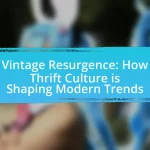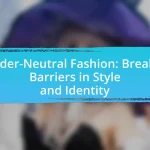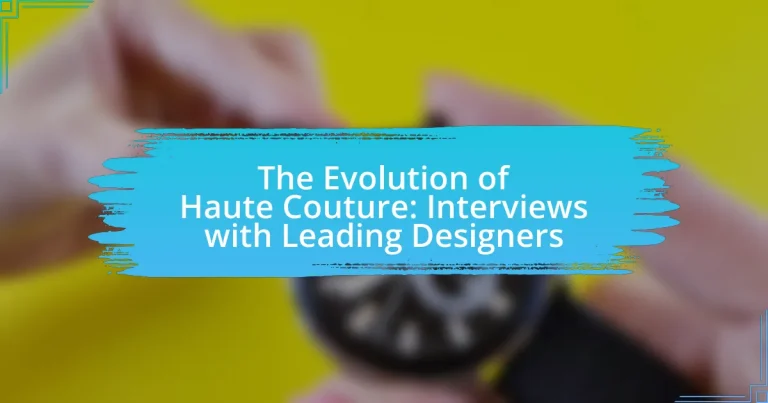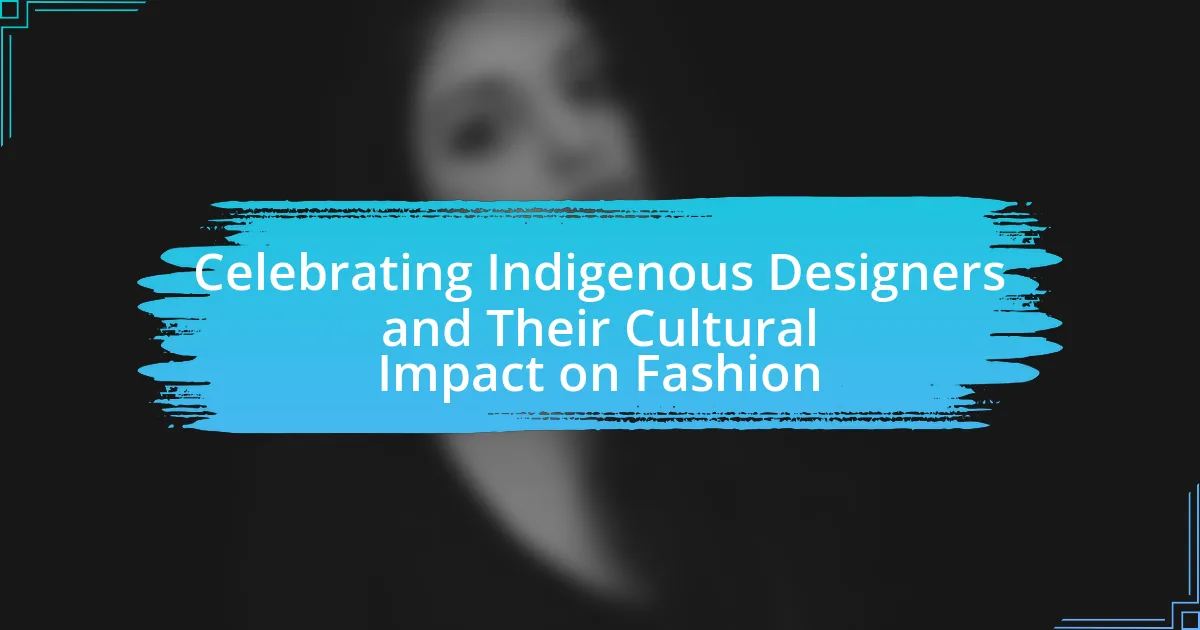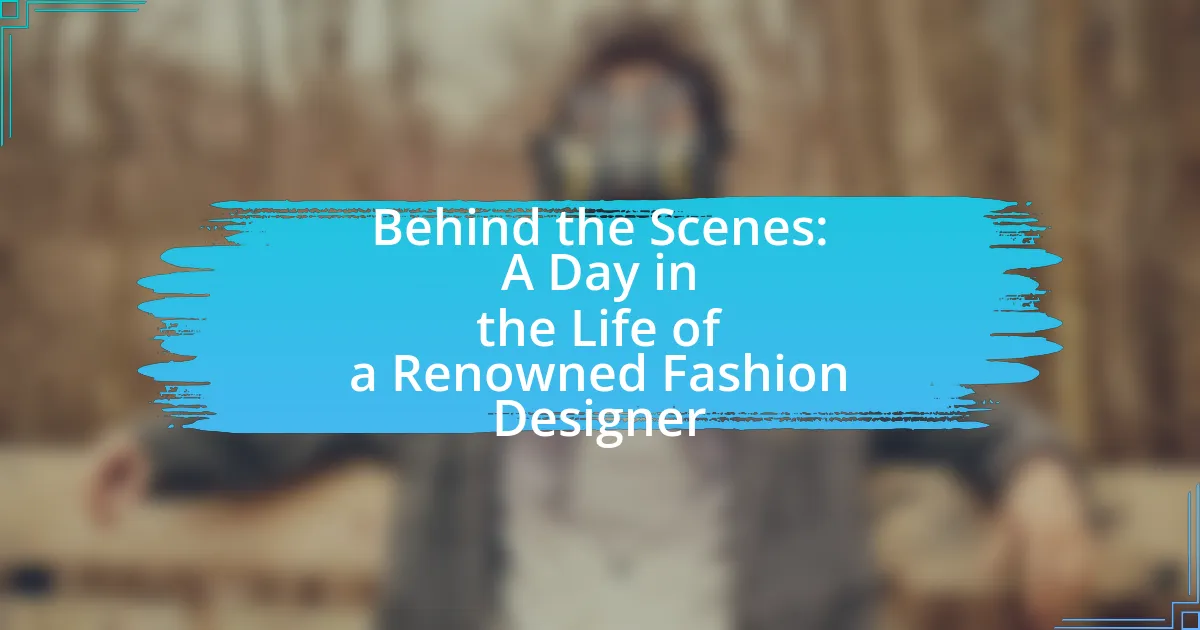The article focuses on the evolution of Haute Couture, a high-end fashion category characterized by custom-fitted garments made from luxurious materials and intricate craftsmanship. It traces the historical significance of Haute Couture from its mid-19th century origins with Charles Frederick Worth to its current status, highlighting key milestones, influential designers, and the impact of societal changes on fashion. The article also examines the unique characteristics that distinguish Haute Couture from other fashion categories, the role of leading designers today, and the future trends shaping the industry, including sustainability and technological innovations. Additionally, it provides insights into the creative processes of designers through interviews, emphasizing the importance of personal narratives and philosophies in understanding contemporary Haute Couture.

What is Haute Couture and its Historical Significance?
Haute Couture refers to the high-end fashion design that is custom-fitted and made from high-quality, expensive fabrics, often characterized by intricate detailing and craftsmanship. Historically, Haute Couture emerged in the mid-19th century, with figures like Charles Frederick Worth establishing the first fashion house in Paris, which set the standard for luxury and exclusivity in clothing. The significance of Haute Couture lies in its role as a symbol of artistic expression and innovation in fashion, influencing trends and styles across the globe while also serving as a benchmark for quality and craftsmanship in the industry. The Chambre Syndicale de la Haute Couture, established in 1868, further solidified its importance by regulating and promoting the standards of Haute Couture, ensuring that it remains a prestigious and influential segment of the fashion world.
How did Haute Couture originate and evolve over time?
Haute Couture originated in the mid-19th century, primarily attributed to Charles Frederick Worth, who is considered the father of modern haute couture. Worth established his fashion house in Paris in 1858, where he began creating custom garments for wealthy clients, thus setting the foundation for the haute couture industry. Over time, haute couture evolved through the establishment of the Chambre Syndicale de la Haute Couture in 1868, which formalized the standards and practices of the industry, ensuring that only certain fashion houses could officially label their creations as haute couture. This evolution continued into the 20th century with influential designers like Coco Chanel and Christian Dior, who introduced innovative styles and techniques, further shaping haute couture’s identity. The industry’s growth was marked by its ability to adapt to cultural shifts and technological advancements, maintaining its status as a symbol of luxury and craftsmanship.
What were the key milestones in the history of Haute Couture?
The key milestones in the history of Haute Couture include the establishment of the first couture house by Charles Frederick Worth in the mid-19th century, which marked the beginning of the industry as we know it. Worth’s innovative approach to fashion design and marketing set the standard for future designers. In 1945, the Chambre Syndicale de la Haute Couture was founded in Paris, formalizing the rules and regulations governing Haute Couture, including the requirement for houses to present a collection of at least 35 looks twice a year. The 1960s saw the rise of ready-to-wear fashion, which challenged traditional Haute Couture but also led to its evolution and adaptation. In the 21st century, designers like John Galliano and Karl Lagerfeld revitalized Haute Couture, blending modern aesthetics with traditional craftsmanship, ensuring its continued relevance in the fashion industry.
How did societal changes influence the development of Haute Couture?
Societal changes significantly influenced the development of Haute Couture by shifting fashion from exclusive, aristocratic styles to more accessible and diverse designs that reflected broader cultural movements. The rise of the middle class during the Industrial Revolution created a demand for fashionable clothing that was not limited to the elite, prompting designers to innovate and cater to a wider audience. Additionally, the women’s suffrage movement in the early 20th century led to changes in women’s roles and expectations, which were mirrored in fashion through more practical and functional designs, such as the introduction of the tailored suit. These societal shifts not only expanded the clientele for Haute Couture but also encouraged designers to embrace new materials and techniques, ultimately shaping the evolution of the fashion industry.
What distinguishes Haute Couture from other fashion categories?
Haute Couture is distinguished from other fashion categories by its exclusive, custom-made garments that are crafted for individual clients, adhering to strict standards set by the Chambre Syndicale de la Haute Couture. This category requires designers to create pieces that involve intricate handwork, high-quality materials, and a minimum of 1,600 hours of labor for each garment, ensuring a level of craftsmanship and personalization that mass-produced fashion cannot replicate. Additionally, Haute Couture collections are presented in private shows, emphasizing the bespoke nature of the designs, which further sets it apart from ready-to-wear and fast fashion segments.
What are the defining characteristics of Haute Couture garments?
Haute Couture garments are defined by their exceptional craftsmanship, exclusivity, and personalized fit. These garments are meticulously handmade, often requiring hundreds of hours of labor, and are constructed from the highest quality fabrics and materials. The exclusivity is emphasized by the fact that each piece is typically made for a specific client, ensuring a unique design that reflects individual style. Additionally, Haute Couture is governed by strict regulations set by the Chambre Syndicale de la Haute Couture, which mandates that collections must be presented twice a year and that garments must be made to order for private clients. This combination of artistry, personalization, and adherence to industry standards solidifies Haute Couture’s status as the pinnacle of fashion design.
How does the Haute Couture process differ from ready-to-wear fashion?
The Haute Couture process differs from ready-to-wear fashion primarily in its exclusivity and customization. Haute Couture involves creating unique, made-to-measure garments for individual clients, often requiring extensive handwork and high-quality materials, while ready-to-wear fashion produces standardized sizes and designs for mass production. Haute Couture pieces are typically presented during exclusive fashion shows and adhere to strict regulations set by the Chambre Syndicale de la Haute Couture, which mandates that garments must be handmade and produced in Paris. In contrast, ready-to-wear collections are designed for broader accessibility and are available in retail stores, reflecting current trends rather than bespoke craftsmanship.
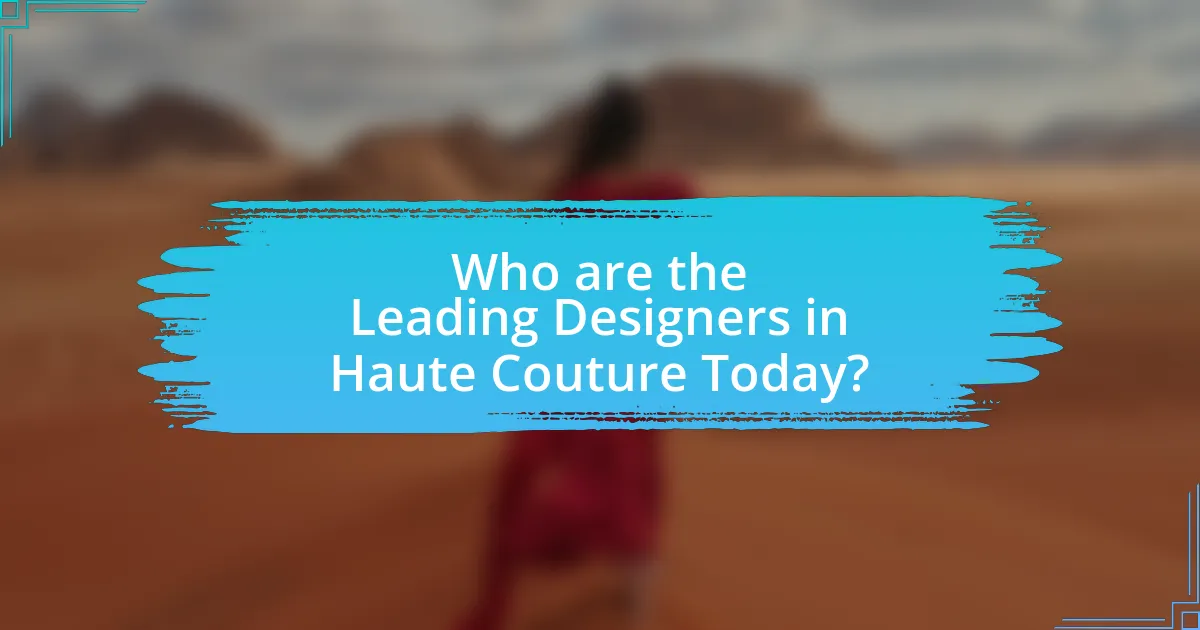
Who are the Leading Designers in Haute Couture Today?
The leading designers in haute couture today include Chanel, Dior, Valentino, Givenchy, and Schiaparelli. These designers are recognized for their innovative approaches and contributions to the fashion industry, consistently showcasing their work during Paris Haute Couture Week. Chanel, under the creative direction of Virginie Viard, continues to uphold the brand’s legacy, while Dior, led by Maria Grazia Chiuri, emphasizes feminist themes in her collections. Valentino, with Pierpaolo Piccioli at the helm, is known for vibrant colors and romantic silhouettes. Givenchy, now under Matthew Williams, merges streetwear with luxury, and Schiaparelli, revitalized by Daniel Roseberry, focuses on surrealism and artistry in fashion. Each of these designers has made significant impacts on haute couture, shaping its evolution in contemporary fashion.
What are the most influential Haute Couture designers currently?
The most influential Haute Couture designers currently include Valentino Garavani, Chanel’s Virginie Viard, and Dior’s Maria Grazia Chiuri. Valentino Garavani continues to shape the industry with his vibrant designs and commitment to craftsmanship, while Virginie Viard has revitalized Chanel’s legacy with modern interpretations of classic styles. Maria Grazia Chiuri at Dior is recognized for her feminist approach to fashion, emphasizing empowerment through her collections. These designers are pivotal in setting trends and influencing the direction of Haute Couture today.
How have these designers shaped the modern landscape of Haute Couture?
These designers have significantly shaped the modern landscape of Haute Couture by redefining craftsmanship, innovation, and inclusivity within the fashion industry. For instance, designers like Karl Lagerfeld and Giorgio Armani introduced a blend of traditional techniques with contemporary aesthetics, making Haute Couture more accessible and relevant to modern consumers. Additionally, the rise of designers such as Raf Simons and Alexander McQueen has pushed the boundaries of creativity, incorporating avant-garde elements and storytelling into their collections, which has transformed Haute Couture into a platform for artistic expression. This evolution is evidenced by the increasing presence of diverse models and the incorporation of sustainable practices, reflecting broader societal changes and consumer demands.
What unique philosophies do these designers bring to their work?
Leading designers in haute couture bring unique philosophies that emphasize individuality, sustainability, and the fusion of art and fashion. For instance, some designers prioritize personal expression, believing that clothing should reflect the wearer’s identity and emotions. Others focus on sustainable practices, integrating eco-friendly materials and ethical production methods to address environmental concerns. Additionally, many designers view their work as a form of art, blurring the lines between fashion and artistic expression, which is evident in their innovative designs and runway presentations. These philosophies not only shape their collections but also influence the broader fashion industry, encouraging a shift towards more conscious and expressive fashion.
What role do interviews play in understanding these designers’ perspectives?
Interviews play a crucial role in understanding designers’ perspectives by providing direct insights into their creative processes, inspirations, and challenges. Through interviews, designers articulate their thoughts and philosophies, revealing the nuances of their work that may not be evident in their finished products. For instance, a study published in the Journal of Fashion Marketing and Management highlights that qualitative interviews allow researchers to capture the subjective experiences of designers, which quantitative methods cannot fully address. This direct communication fosters a deeper comprehension of the cultural and emotional contexts that influence haute couture, thereby enriching the overall narrative of the fashion industry.
How can interviews reveal the creative processes of Haute Couture designers?
Interviews can reveal the creative processes of Haute Couture designers by providing direct insights into their inspirations, techniques, and decision-making strategies. Through discussions, designers articulate their conceptual frameworks, detailing how they translate artistic visions into tangible garments. For instance, interviews often uncover the significance of cultural influences, personal experiences, and historical references that shape their collections. Additionally, designers may describe their collaborative processes with artisans and the meticulous craftsmanship involved, highlighting the intricate steps from initial sketches to final pieces. This firsthand narrative not only enhances understanding of their creative journeys but also contextualizes their work within the broader fashion landscape.
What insights can be gained from personal stories shared by these designers?
Personal stories shared by designers provide insights into their creative processes, influences, and the challenges they face in the fashion industry. These narratives often reveal how personal experiences shape their design philosophies and aesthetic choices, illustrating the connection between individual identity and artistic expression. For instance, a designer may recount how cultural heritage informs their work, highlighting the importance of authenticity in haute couture. Additionally, these stories can shed light on the evolution of fashion trends and the impact of societal changes on design, offering a deeper understanding of the industry’s dynamics. Such insights are crucial for comprehending the broader context of haute couture and the personal journeys that drive innovation within it.
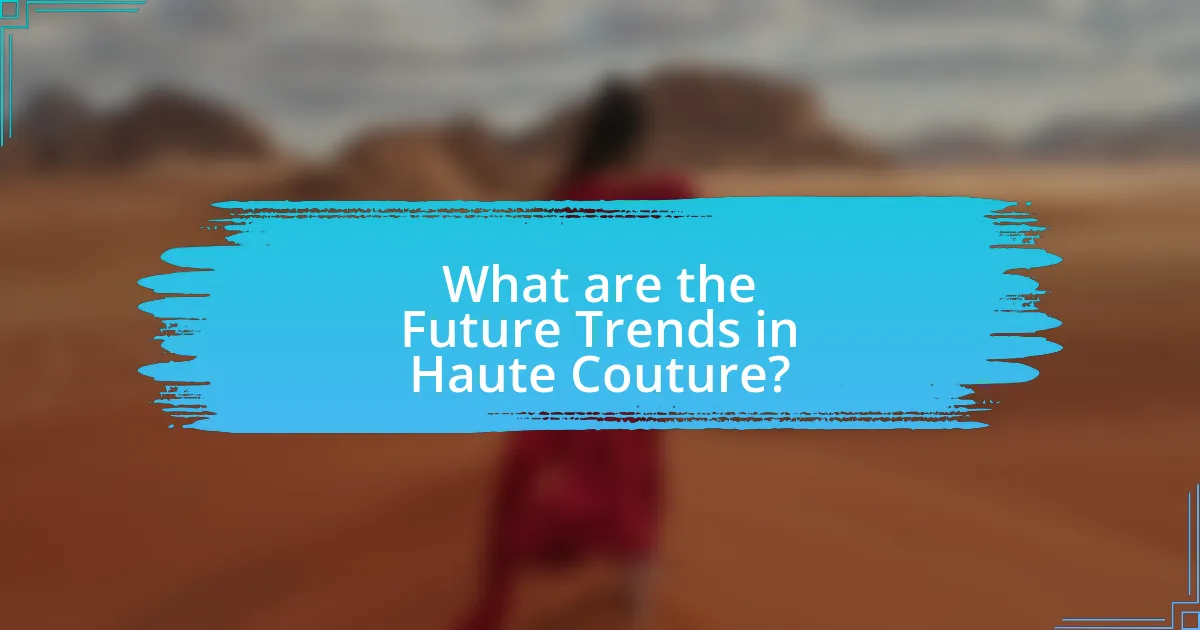
What are the Future Trends in Haute Couture?
Future trends in haute couture include a significant shift towards sustainability, digital innovation, and inclusivity. Designers are increasingly prioritizing eco-friendly materials and ethical production methods, responding to consumer demand for sustainable fashion. For instance, brands like Stella McCartney have pioneered the use of recycled fabrics and cruelty-free practices, setting a precedent in the industry. Additionally, the integration of technology, such as 3D printing and virtual reality, is transforming the design process and consumer experience, allowing for personalized and interactive fashion. Furthermore, inclusivity is becoming a focal point, with designers expanding size ranges and showcasing diverse models, reflecting a broader societal push for representation in fashion. This evolution is evident in collections from houses like Balenciaga and Gucci, which have embraced these principles in recent seasons.
How is technology impacting the future of Haute Couture?
Technology is significantly transforming the future of Haute Couture by enhancing design processes, improving customization, and streamlining production. Advanced tools such as 3D printing and computer-aided design (CAD) allow designers to create intricate patterns and prototypes with precision, reducing the time and cost associated with traditional methods. For instance, 3D printing enables the production of complex garments that were previously impossible to achieve, thus expanding creative possibilities. Additionally, technologies like artificial intelligence and data analytics are being utilized to predict fashion trends and consumer preferences, allowing designers to tailor their collections more effectively. This integration of technology not only fosters innovation but also promotes sustainability by minimizing waste through more efficient production techniques.
What innovations are being integrated into Haute Couture design and production?
Innovations being integrated into Haute Couture design and production include the use of 3D printing, sustainable materials, and digital design technologies. 3D printing allows for intricate designs and rapid prototyping, enabling designers to create complex structures that were previously difficult to achieve. Sustainable materials, such as organic fabrics and recycled textiles, are increasingly being adopted to address environmental concerns and promote ethical fashion practices. Digital design technologies, including virtual reality and augmented reality, enhance the design process by allowing designers to visualize garments in a virtual space before production, streamlining the workflow and reducing waste. These innovations reflect a shift towards more efficient, sustainable, and technologically advanced practices in Haute Couture.
How are sustainability and ethical practices influencing Haute Couture?
Sustainability and ethical practices are significantly influencing Haute Couture by prompting designers to adopt eco-friendly materials and transparent production processes. Many leading designers are now prioritizing sustainable fabrics, such as organic cotton and recycled materials, to reduce environmental impact. For instance, brands like Stella McCartney have pioneered the use of vegan leather and sustainable textiles, showcasing that luxury can align with environmental responsibility. Additionally, ethical practices are reshaping labor standards within the industry, with a growing emphasis on fair wages and safe working conditions for artisans. This shift not only enhances brand reputation but also meets the increasing consumer demand for responsible fashion, as evidenced by a 2021 McKinsey report indicating that 67% of consumers consider sustainability when making luxury purchases.
What challenges do Haute Couture designers face in the modern fashion industry?
Haute Couture designers face significant challenges in the modern fashion industry, primarily due to the high costs of production and the demand for rapid turnaround times. The intricate craftsmanship and luxurious materials required for Haute Couture often lead to exorbitant expenses, making it difficult for designers to maintain profitability. Additionally, the rise of fast fashion has shifted consumer expectations towards immediacy, pressuring Haute Couture designers to adapt their timelines while preserving the artistry and exclusivity that define their work. This tension between traditional craftsmanship and modern market demands creates a complex landscape for Haute Couture designers, as they strive to innovate while staying true to their heritage.
How are economic factors affecting the Haute Couture market?
Economic factors significantly influence the Haute Couture market by affecting consumer spending and production costs. For instance, during economic downturns, luxury spending typically declines as consumers prioritize essential goods over high-end fashion, leading to reduced sales for Haute Couture brands. Additionally, fluctuations in raw material prices, such as silk and high-quality fabrics, directly impact production costs, which can result in higher prices for consumers or reduced profit margins for designers. According to a report by Bain & Company, the global luxury market, including Haute Couture, saw a contraction of 23% in 2020 due to the COVID-19 pandemic, illustrating how economic conditions can drastically alter market dynamics.
What strategies are designers employing to adapt to changing consumer preferences?
Designers are employing strategies such as incorporating sustainable materials, leveraging technology for customization, and enhancing direct consumer engagement to adapt to changing consumer preferences. The shift towards sustainability is evidenced by a growing demand for eco-friendly fabrics and ethical production practices, with brands like Stella McCartney leading the way. Additionally, the use of technology, such as 3D printing and virtual fitting rooms, allows designers to offer personalized experiences that cater to individual consumer needs. Enhanced engagement through social media platforms enables designers to gather real-time feedback and trends, ensuring their collections resonate with current consumer desires.
What practical tips can aspiring designers learn from leading Haute Couture designers?
Aspiring designers can learn the importance of craftsmanship and attention to detail from leading Haute Couture designers. These designers emphasize the necessity of mastering sewing techniques and fabric manipulation, as evidenced by the intricate handwork seen in collections from houses like Chanel and Dior. Additionally, they advocate for a strong personal vision and creativity, encouraging designers to develop a unique aesthetic that sets them apart in a competitive industry. This is supported by the success of designers such as Alexander McQueen, who was known for his innovative designs that challenged conventional fashion norms. Lastly, networking and building relationships within the industry are crucial, as many leading designers attribute their success to collaborations and mentorships that helped them navigate their careers.
How can emerging designers develop their unique style in Haute Couture?
Emerging designers can develop their unique style in Haute Couture by focusing on personal identity, innovative techniques, and cultural influences. Personal identity allows designers to express their individuality through distinct aesthetics, while innovative techniques, such as experimenting with fabrics and construction methods, can set their work apart. Cultural influences, including heritage and contemporary societal themes, provide rich sources of inspiration that can lead to unique design narratives. Historical examples, such as Alexander McQueen’s use of theatricality and cultural commentary, illustrate how these elements can culminate in a signature style that resonates within the Haute Couture landscape.
What resources are available for learning about Haute Couture techniques?
Books, online courses, and workshops are key resources for learning about Haute Couture techniques. Notable books include “Haute Couture: The History of High Fashion” by Caroline Rennolds Milbank, which provides historical context and insights into techniques. Online platforms like MasterClass offer courses taught by renowned designers, while institutions such as the Fashion Institute of Technology and Central Saint Martins provide specialized workshops and programs focused on Haute Couture skills. These resources collectively offer a comprehensive foundation for understanding and mastering Haute Couture techniques.
